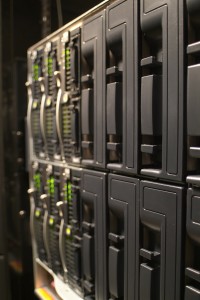 The keyword may be “virtual” but an exploratory information technology project aims to bring Iowa State University some very real cost savings.
The keyword may be “virtual” but an exploratory information technology project aims to bring Iowa State University some very real cost savings.
Virtual Desktop Infrastructure (VDI), also known as thin client technology, isn’t a new idea in the IT world. In fact, it’s a proven approach to saving energy, money, and space. Successfully implementing that idea, though, requires an important change of approach in IT service delivery.
At Iowa State, the university-level Information Technology Services unit and the College of Engineering’s own IT staff have led the development of a solid infrastructure and teamed with others on campus to put the university at the forefront of this service delivery trend.
“The virtual desktop technology is coming of age at Iowa State because we have invested in the infrastructure and partnerships that are necessary to make this approach work,” said Iowa State President Gregory Geoffroy. “This project is truly representative of a progressive management model for information technology.”
While that approach is not being applied exclusively to the College of Engineering—the president’s own office is adopting VDI—the engineering college is an excellent proving ground because of its leadership in other IT initiatives and the overall complexity of bringing this technology to highly technical labs and classrooms.
Jonathan Wickert, dean of engineering, said there is a strong motivation to innovate.
“We’re looking for ways to help the university integrate IT services for the betterment of students, faculty, our corporate partners, and outreach to the public,” Wickert said. “We want to be the best possible stewards we can be with taxpayer funds.”
The primary objective seems straightforward enough: replace desktop computers with display units that are tied to servers. Instead of each person having a “box where everything is run locally,” explained Jim Davis, chief information officer at Iowa State, all the processing is done on the server side.
“That’s the fundamental shift,” Davis said. “You can take an office full of computers and move that processing power and software back to the server and combine it there, so what actually sits in the office is a lot less expensive and uses a lot less energy. It’s a very powerful paradigm and one that lowers IT costs.”
Davis said it’s generally believed that the virtual desktop approach will reduce the total cost of ownership for clients by 50 percent. Part of the engineering project, he said, will be to verify those savings.
But the benefits extend beyond the obvious reduction of energy and need to constantly purchase more “boxes.” Stability is enhanced, Davis said, because if the hardware fails, then all the virtual machines running on it can quickly be switched to another system.
In addition, this approach creates a dynamic environment that allows IT services to help clients easily and quickly adapt to changing needs.
“What will make it work well on this campus is that we have invested in a really good infrastructure of virtualized servers and storage, which is the core that this technology needs to run on,” Davis said. “We’ve invested in it as a campus solution.”
Contact:
John McCarroll, University Relations, 515 294-6137, jmccarol@iastate.edu
Jim Davis, IT Services, 515 294-0323, davis@iastate.edu
Eric Dieterle, Engineering Communications, 515 294-4881, dieterle@iastate.edu